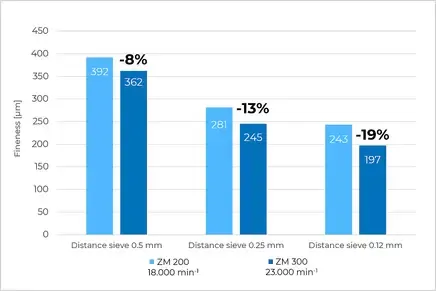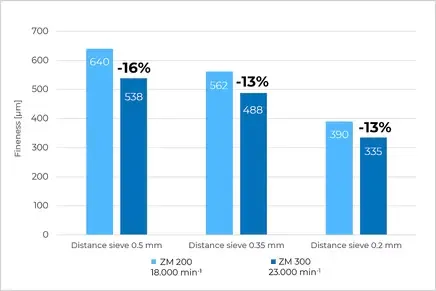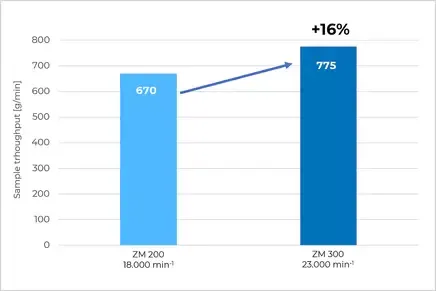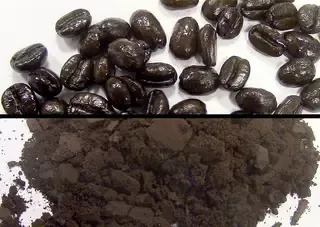

ZM 300 is a universal rotor mill for grinding soft and sensitive materials
Rotor mills are used for high-speed size reduction of soft to medium-hard as well as temperature-sensitive or fibrous materials.
THE STANDARD FOR FOOD & FEED
- Gentle high-speed pulverization due to pre- and fine grinding in one working run
- Optimum process control and reproducibility based on monitoring of the cassette temperature
- Patented cassette system for maximum sample recovery and easy cleaning
- Optional cassette for sample volumes up to 600 ml
- Wide speed range from 6,000 to 23,000 rpm
- Defined final fineness due to ring sieves with aperture sizes from 0.08 – 10 mm
- Collecting vessels for sample volumes from 250 ml to 4.5 l
- Automated vibratory feeder and various cyclone systems available
INCREASED REPRODUCIBILITY THROUGH TEMPERATURE MONITORING
The speed range from 6000 to 23000 rpm allows for optimum adaptation of the grinding process to the sample requirements by keeping the grinding time as short as possible and the temperature increase as moderate as possible. Too much heat may have a negative effect on the grinding results, for example, if moisture or volatile components escape.
The ZM 300 is equipped with an integrated temperature sensor which measures the temperature of the cassette lid near the ring sieve. The measured temperature is constantly shown in the mill’s display, allowing the user to optimize the grinding process and improve reproducibility.
MAXIMUM SPEED FOR HIGH FINAL FINENESS AND INCREASED THROUGHPUT
The maximum speed of classic centrifugal mills, like the widely used ZM 200, is usually limited to 18,000 rpm (rotor peripheral speed 98 m/s). The ZM 300 achieves a maximum speed of 23,000 rpm (rotor peripheral speed 118 m/s) and produces particles which are 15 to 20 % finer in comparison, depending on the material.
The higher speed has a particularly positive impact on the grind sizes of polymer samples which are pulverized cryogenically, or of fibrous materials like hay. Compared to models with a maximum speed of 18,000 rpm, the throughput may be increased by 10 to 15 %.
APPLICATION EXAMPLES
Grind sizes of plastic materials (POM or PP) after grinding with different sieves and speeds. The speed of 23,000 rpm results in a higher fineness for all sieves compared to grinding at 18,000 rpm. For example, a 19 % reduction in fineness can be achieved when POM is ground with a 0.12 mm distance sieve at 23,000 rpm.
The maximum sample throughput, e.g. when crushing chicken feed with a 0.5 mm ring sieve, could be increased by 16% when crushing at maximum speed of 23,000 min-1 instead of 18,000 min-1.



REDUCING THE FINE FRACTION
The fines content in a pulverized sample can be controlled by speed reduction. If, for example, the grains of an animal feed sample are to be coarsely ground to avoid dust formation, a reduction to 6,000 - 10,000 rpm will provide the desired result.
Thanks to the variable speed, the ZM 300 can be flexibly adapted to all requirements in the food and feed industry, chemical industry, and in agriculture.
CRYOGENIC GRINDING
Cryogenic or cold grinding is the ideal solution for pulverizing samples that cannot be reduced to the required fineness at room temperature. This procedure involves the use of grinding aids such as liquid nitrogen (-196 °C, embrittlement of the sample outside the mill) or dry ice (-78 °C, sample/dry ice mixture) to embrittle the sample material by cooling, and thus improve the breaking behavior.
In addition, highly volatile components are better preserved in the sample by cooling. Cryogenic grinding is easy to perform with the ZM 300 and is recommended especially for plastics or very temperature-sensitive samples. The video shows the process with the predecessor model ZM 200, which is identical in the ZM 300.
IDEAL FOR LIGHT & HEAT-SENSITIVE MATERIALS
When operated with the optional cyclone-suction-combination, the ZM 300 is also suitable for grinding low-density or heat-sensitive sample materials.
- Efficient cooling of sample and grinding tools
- Improved sample discharge from the grinding chamber
- Particularly suitable for large volumes
- The cyclone accommodates sample bottles of 0.25, 3 and 5 liters
- Ideal for cryogenic grinding
CONVENIENT OPERATION AND EASY CLEANING
The ZM 300 is easy and safe to operate. The large touch display with rotary knob permits convenient entry of the grinding parameters. It shows the current cassette temperature and load during grinding which helps to prevent overloads by feeding the sample too quickly.
TYPICAL SAMPLE MATERIALS
The versatile Ultra Centrifugal Mill ZM 300 processes materials such as bones, cereals, chemical products, coal, coffee beans, collagen, corn, dried fruit and vegetables, dried larvae, drugs, electronic components, feed pellets, fertilizers, food, grain, graphite, minerals, paper, pharmaceutical materials, plant materials, polymers, powder coatings, rice, rubber, seeds, spices, straw, sweets, textiles, tobacco, waste, wood



 TECHNICAL DATA
TECHNICAL DATA
| Applications | fine grinding |
| Field of application | agriculture, biology, chemistry / plastics, construction materials, engineering / electronics, environment / recycling, food, geology / metallurgy, medicine / pharmaceuticals |
| Feed material | soft, medium-hard, brittle, fibrous |
| Size reduction principle | impact, shearing |
| Material feed size* | < 10 mm |
| Final fineness* | < 40 µm |
| Batch size / feed quantity* | 300 ml with standard cassette
600 ml with volume cassette 4500 ml / 2500 ml / 450 ml / 230 ml with cyclone |
| Speed at 50 Hz (60 Hz) | 6,000 - 23,000 min-1, free selectable |
| Rotor peripheral speed | 31 - 119 m/s |
| Rotor diameter | 99 mm |
| Types of rotors | 6-tooth rotor / 12-tooth rotor / 24-tooth rotor |
| Material of grinding tools | stainless steel, titanium, stainless steel with wear-resistant coating |
| Sieve sizes | trapezoid holes 0.08 / 0.12 / 0.20 / 0.25 / 0.50 / 0.75 / 1.00 / 1.50 / 2.00 mm
round holes 3.00 / 4.00 / 5.00 / 6.00 / 10.00 mm |
| Setting of grinding time | no |
| Collector capacity | 900 ml with standard cassette
1200 ml with volume cassette 5000 ml / 3000 ml / 500 ml / 250 ml with cyclone |
| Drive | Drive |
| Power connection | 1-phase |
| Protection code | IP 20 |
| Power consumption | 1750 VA ((200..240V), 1400 VA (110..120V) |
| W x H x D closed | 452 x 431 x 426 mm |
| Net weight | ~ 38 kg |
| Standards | CE |
